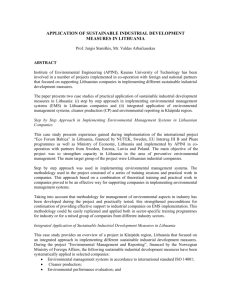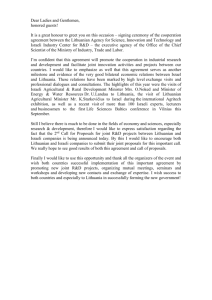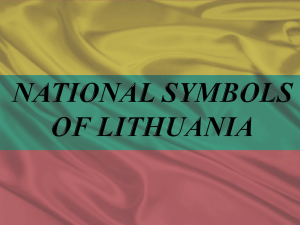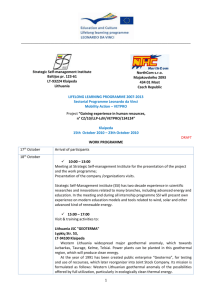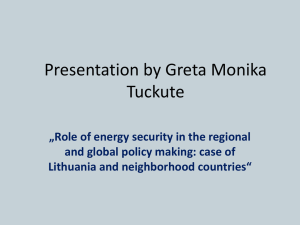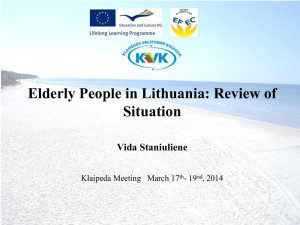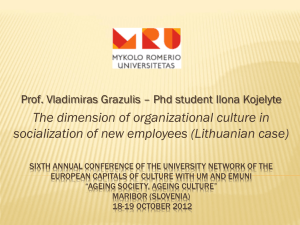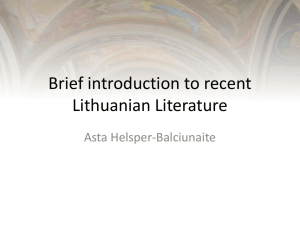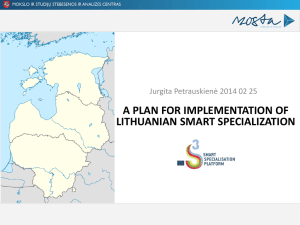Assessment of energy security level
advertisement
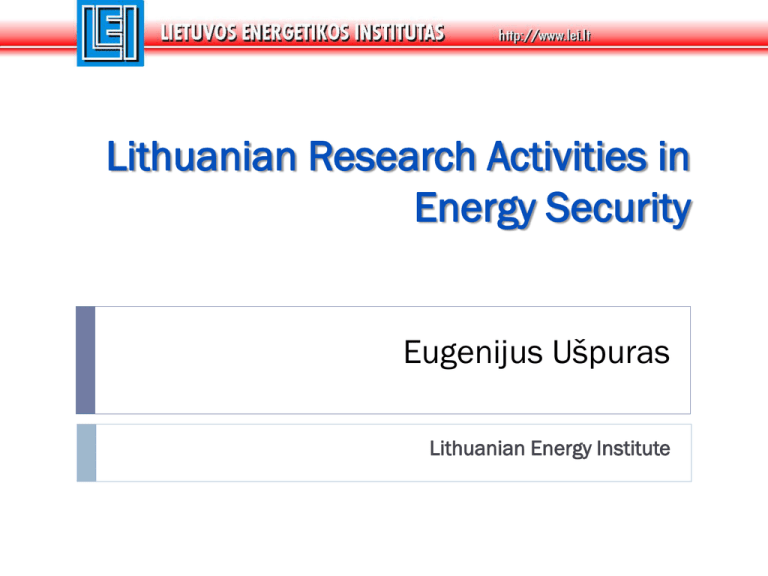
Lithuanian Research Activities in Energy Security Eugenijus Ušpuras Lithuanian Energy Institute Content 1. 2. 3. 4. Energy security (research) institutions Energy security research in Lithuania Security of Energy Supply Security of Energy Infrastructures Energy security (research) institutions Lithuanian Energy Institute (established in 1956) Energy Security Research Centre – founded by Vytautas Magnus University (VMU) and Lithuanian Energy Institute (LEI) in 2008 NATO Energy Security Centre of Excellence, established on 10 July 2012 (previously – Energy Security Center under the Ministry of Foreign Affairs of the Republic of Lithuania) Other institutions Energy security research in Lithuania (1) Ignalina NPP. Lithuanian Energy Institute (LEI) (Risk analysis, Accidents analysis); Lithuanian Energy Strategy (1999; 2002; 2005: 2007); Special Studies (e.g. Ignalina NPP decommissioning impact to Lithuanian economic security after 2010). Energy security research in Lithuania (2) State funded research project Development of methodologies of Security and Reliability Assessment of Energy Supply to Lithuania (2006-2008; 2009-2011). Research Council of Lithuania funded National research programme Future Energy project Development of Methodology for Energy Security Analysis and Integrated Security Level Assessment (2010 – 2011). Energy security research in Lithuania (3) Research Council of Lithuania funded National research programme Future Energy project Development of Methodology for Optimal Integration of Future Technologies into Energy Sector (2011-2012). Research Council of Lithuania funded National research programme Future Energy project Investigation of Lithuanian energy security and energy security level assessment (2012-2014). Energy security research in Lithuania (4) 7FP project Security of Energy Considering Its Uncertainty, Risk and Economic Implications (SECURE) (2008-2010). The project developed appropriate tools for evaluating the vulnerability of the EU to the different energy supply risks, and for promoting the optimization of EU energy insecurity mitigation strategies, including investment, demand side management and dialogue with producing countries. SECURE partners from France, Italy, Denmark, Lithuania (LEI), JRC, Germany, Switzerland, Russian Federation, UK, Belgium, Austria. Energy security research in Lithuania (5) Leonardo da Vinci programme project European energy supply security management coordinators UNDER way towards STANDard indicators for continuous vocational education and training (UNDERSTAND) (2006-2008). UNDERSTAND is a pilot training project which is intended for the emergency planners and emergency operators of the European energy supply, transmission system operators (TSOs) in particular. UNDERSTAND partners from Sweden, Finland, Denmark, Czech Republic, Lithuania (LEI), UK, Italy, Slovak Republic Energy security research we could divide into two branches: Security of Energy Supply Security of Energy Infrastructures Security of Energy Supply Assessment of Security of Energy Supply Different approaches are used for assessing security of energy supply in Lithuanian Energy Institute: • economical modelling (MESSAGE model), • disturbances impact to the energy system assessment employing probabilistic and deterministic models • development of security indicators system for the assessment of energy security level. Lithuanian electricity system model Latvia, Estonia, Finland, Russia Sweden (Nordpool) Belarus, Russia (IPS/UPS) Lithuanian electricity system Lithuanian district heating system Kaliningrad (IPS/UPS) Poland, (ENTSO-E) Diagram of renewable energy sources flow Economical modelling MESSAGE MODEL • model is designed for planning energy sector in long perspective, where could be predictable technological process; • optimization function is minimization of costs of energy system during the considered period. •Using model it is possible to assess and compare different energy development strategies, alternatives of using different energy resources or new energy technologies. •Applying sensitivity analysis it is possible to investigate the influence of particular indicators to functioning of energy system. Results: • costs of energy production, then exits limitations of: primary energy resources, environment, policy. Scheme of Energy security assessment methodology Analysis of threats of energy system Investigation of disturbances development Technical, economic and sociopolitical information Disturbed energy system modelling by Economic models Disturbed energy system modelling by Probabilistic models Energy security indicators Analysis of energy security level Conclusions Results of energy security analysis Recommendations Probabilistic Energy Security Analysis Threats Barriers Auxiliary systems Natural Diversification Economical Physical protection Sociopolitical Safety systems Terrorism Long term agreements Energy system Consequences mitigation Emergency plans Generators, power distribution Warning and system power supply networks, First-aid storages, suppliers, Evacuation consumers. Deactivation War conflicts Diplomacy Consequences Human lifes Damages of infrastructure Economical losses Sociopolitical disturbances Assessment of Energy Security Level Steps: • Description of energy security indicators; • Grouping of indicators to different blocks; • Estimation of critical and precritical values of security indicators; • Assessment of weights for indicators and blocks of indicators; • Performance of sensitivity analysis of indicators in critical situations; • Setting of indicators correlations matrix; • Setting of functional systems and equations, which consists parameters energy security of supply; • Calculation of energy security level. Creation of a Security of Supply Index • Index allows for country specific characteristics • Allows for assessment of SoS impact of new investments and policies • Allows for analysis of scenarios Export share of production SECURE - NATURAL GAS STAKEHOLDER MEETING Ramboll Oil & Gasas.com Stefan Schaar Kruse Senior Economist Reserves / consumption External Suppliers National storages Border crossings Country risk to border Replaceable share of gas Production share of consumption Security of Supply LNG terminals Import pipelines Offshore pipelines risk Security of Supply in the EU – Risk and Impact High SoS Low impact –High SoS Low SoS Low impact –Low SoS High impact –High SoS High impact –Low SoS • Swiden • Finland Low impact High Impact Security of energy supply is assessed by analysing various energy system development scenarios For example, just revising the last energy strategy more than 70 different development scenarios were analysed All scenarios energy production price with various restrictions taking into account energy security were taken into account Analysed energy system development scenarios Analysed scenarios were grouped in the following group: Group of scenarios with various restrictions to the electricity import Flexible non-nuclear scenarios without nuclear power plant Scenarios with new nuclear power plant Energy security level of analysed scenarios 0.9 New CHP gas unit 0.85 SC1-import SC2-CHP SC3-NPP SC4-CHP+NPP Energy security coefficient 0.8 0.75 NordBalt 0.7 LNGT LitPolLink1 0.65 LitPolLink2 Shutdown of LPP 5th and 6th units New CHP gas unit New NPP 0.6 Shutdown of LPP 7th and 8th units 0.55 0.5 2013 2014 2015 2016 2017 2018 2019 2020 2021 2022 Year 2023 2024 2025 2026 2027 2028 2029 2030 Economic analysis showed that scenarios with nuclear energy and restricted electricity import has slightly higher energy price Assessing energy security as price increase and system resistance to possible perturbations, we can state that scenarios nuclear energy has higher energy security level Security of Energy Infrastructures Two approaches are used: Deterministic Probabilistic 1. 2. The solution of the infrastructure security problem is consisting of two parts: Identification of the critical elements of the infrastructure, the development of security plans. The analysis and assessment of infrastructure criticality. Scheme of energy infrastructure Scheme of energy infrastructure (Lithuanian case) Probabilistic Assessment of Critical Infrastructures Reliability and Security Assessment of Lithuanian Power Transmission System. Risk analysis of petrol transportation by trucks through Lithuanian roads Probabilistic Assessment of Kaunas Hydropower System Kaunas hydropower plant (KHP) KHP dam Flooding zone Kruonis hydro pump storage power plant (KHSP) Analysis of Aircraft Crash Structural response, Global level. Structural response, Semi-global level. Structural response, Local level. Fire analysis. Global Analysis of Aircraft Crash Concluding remarks In Lithuania we have developed and approved methodology for energy security analysis Energy security assessment is significant only when it is compared with other countries or regions. For that reason unified understanding of energy security and usage of the common methodology should be implemented Methodologies developed in Lithuania could be a good starting point at least in Baltic States to introduce unified energy security assessment concept. That would enable to assess separate projects and entire situation. Concluding remarks Despite the fact that research in the field of energy security is performed in Lithuania, further collaboration and integration of efforts in this field should be accomplished in Baltic Sea region and entire Europe. Thank you for your attention Eugenijus Ušpuras uspuras@mail.lei.lt
